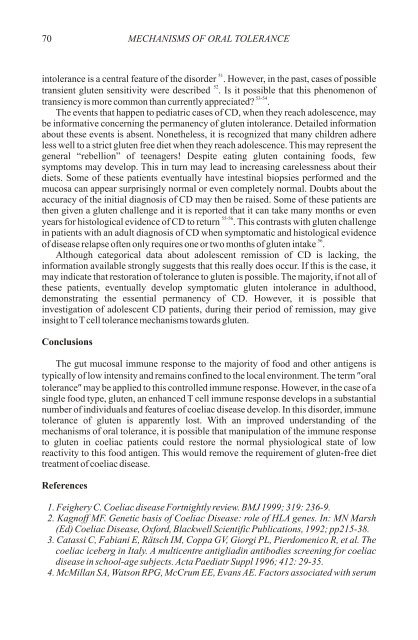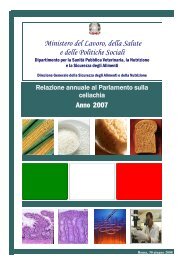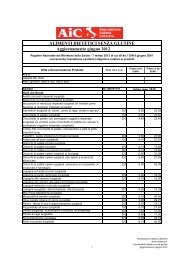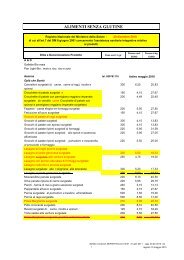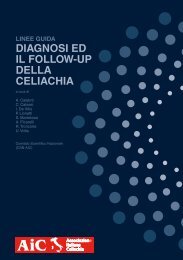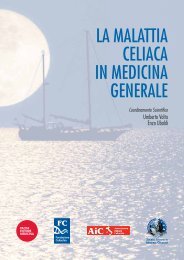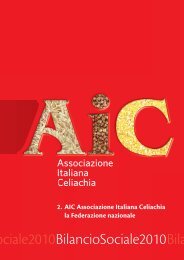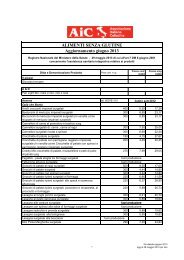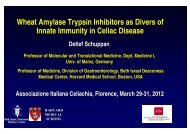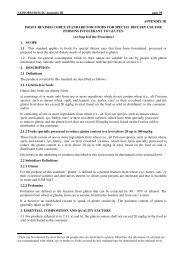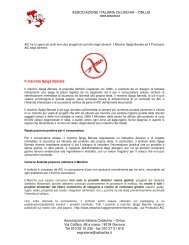primary prevention of coeliac disease - Associazione Italiana ...
primary prevention of coeliac disease - Associazione Italiana ...
primary prevention of coeliac disease - Associazione Italiana ...
You also want an ePaper? Increase the reach of your titles
YUMPU automatically turns print PDFs into web optimized ePapers that Google loves.
70 MECHANISMS OF ORAL TOLERANCE<br />
51<br />
intolerance is a central feature <strong>of</strong> the disorder . However, in the past, cases <strong>of</strong> possible<br />
52<br />
transient gluten sensitivity were described . Is it possible that this phenomenon <strong>of</strong><br />
53-54<br />
transiency is more common than currently appreciated? .<br />
The events that happen to pediatric cases <strong>of</strong> CD, when they reach adolescence, may<br />
be informative concerning the permanency <strong>of</strong> gluten intolerance. Detailed information<br />
about these events is absent. Nonetheless, it is recognized that many children adhere<br />
less well to a strict gluten free diet when they reach adolescence. This may represent the<br />
general “rebellion” <strong>of</strong> teenagers! Despite eating gluten containing foods, few<br />
symptoms may develop. This in turn may lead to increasing carelessness about their<br />
diets. Some <strong>of</strong> these patients eventually have intestinal biopsies performed and the<br />
mucosa can appear surprisingly normal or even completely normal. Doubts about the<br />
accuracy <strong>of</strong> the initial diagnosis <strong>of</strong> CD may then be raised. Some <strong>of</strong> these patients are<br />
then given a gluten challenge and it is reported that it can take many months or even<br />
55-56<br />
years for histological evidence <strong>of</strong> CD to return . This contrasts with gluten challenge<br />
in patients with an adult diagnosis <strong>of</strong> CD when symptomatic and histological evidence<br />
56<br />
<strong>of</strong> <strong>disease</strong> relapse <strong>of</strong>ten only requires one or two months <strong>of</strong> gluten intake .<br />
Although categorical data about adolescent remission <strong>of</strong> CD is lacking, the<br />
information available strongly suggests that this really does occur. If this is the case, it<br />
may indicate that restoration <strong>of</strong> tolerance to gluten is possible. The majority, if not all <strong>of</strong><br />
these patients, eventually develop symptomatic gluten intolerance in adulthood,<br />
demonstrating the essential permanency <strong>of</strong> CD. However, it is possible that<br />
investigation <strong>of</strong> adolescent CD patients, during their period <strong>of</strong> remission, may give<br />
insight to T cell tolerance mechanisms towards gluten.<br />
Conclusions<br />
The gut mucosal immune response to the majority <strong>of</strong> food and other antigens is<br />
typically <strong>of</strong> low intensity and remains confined to the local environment. The term ²oral<br />
tolerance²may be applied to this controlled immune response. However, in the case <strong>of</strong> a<br />
single food type, gluten, an enhanced T cell immune response develops in a substantial<br />
number <strong>of</strong> individuals and features <strong>of</strong> <strong>coeliac</strong> <strong>disease</strong> develop. In this disorder, immune<br />
tolerance <strong>of</strong> gluten is apparently lost. With an improved understanding <strong>of</strong> the<br />
mechanisms <strong>of</strong> oral tolerance, it is possible that manipulation <strong>of</strong> the immune response<br />
to gluten in <strong>coeliac</strong> patients could restore the normal physiological state <strong>of</strong> low<br />
reactivity to this food antigen. This would remove the requirement <strong>of</strong> gluten-free diet<br />
treatment <strong>of</strong> <strong>coeliac</strong> <strong>disease</strong>.<br />
References<br />
1. Feighery C. Coeliac <strong>disease</strong> Fortnightly review. BMJ 1999; 319: 236-9.<br />
2. Kagn<strong>of</strong>f MF. Genetic basis <strong>of</strong> Coeliac Disease: role <strong>of</strong> HLA genes. In: MN Marsh<br />
(Ed) Coeliac Disease, Oxford, Blackwell Scientific Publications, 1992; pp215-38.<br />
3. Catassi C, Fabiani E, Rätsch IM, Coppa GV, Giorgi PL, Pierdomenico R, et al. The<br />
<strong>coeliac</strong> iceberg in Italy. A multicentre antigliadin antibodies screening for <strong>coeliac</strong><br />
<strong>disease</strong> in school-age subjects. Acta Paediatr Suppl 1996; 412: 29-35.<br />
4. McMillan SA, Watson RPG, McCrum EE, Evans AE. Factors associated with serum


